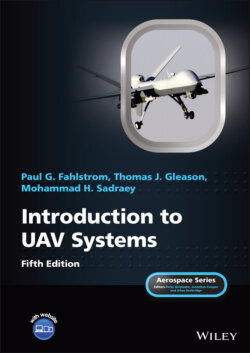Читать книгу Introduction to UAV Systems - Mohammad H. Sadraey - Страница 39
1.4.7 Summary
ОглавлениеThe Aquila system had everything imaginable in what one could call “The Complete UAV System;” “zero‐length” launcher, “zero‐length” automatic recovery with a net, anti‐jam data link, and day and night payload with designator. This came at a very high cost, however – not only in dollars but also in terms of manpower, trucks, and equipment. The complete system became large and unwieldy, which contributed to its downfall. All of this equipment was necessary to meet the elaborate operational and design requirements placed on the Aquila system by the Army, including a level of nuclear blast and radiation survivability (a significant contributor to the size and weight of shelters and the RGT mount). Eventually, it was determined that many of the components of the system could be made smaller and lighter and mounted on HMMWVs instead of 5‐ton trucks, but by that time the whole system had gained a bad reputation for:
Having been in development for over 10 years;
Being very expensive;
Requiring a great deal of manpower, a large convoy of heavy trucks for mobility, and extensive support;
What was widely perceived to be a poor reliability record (driven by the complexity of the data link, air‐vehicle subsystems, and the zero‐length recovery system);
Failure to meet some operational expectations that were unrealistic, but had been allowed to build up during the development program because the system developers did not understand the limitations of the system.
Foremost among the operational “disappointments” was that Aquila turned out to be unable to carry out large‐area searches for small groups of infiltrating vehicles, let alone personnel on foot. This failing was due to limitations on the sensor fields of view and resolution and on shortcomings in the system‐level implementation of the search capability. It also was partly driven by the failure to understand that searching for things using an imaging sensor on a UAV required personnel with special training in techniques for searching and interpretation of the images provided. The sources of these problems and some ways to reduce this problem by a better system‐level implementation of area searches are addressed in the discussions of imaging sensors in Part Four and data links in Part Five.
The Aquila program was terminated as a failure, despite having succeeded in producing many subsystems and components that individually met all of their requirements. The US Army Red Team concluded that there had been a pervasive lack of systems engineering during the definition and design phases of the program. This failure set back US efforts to field a tactical UAS on an Army‐wide basis, but opened the door for a series of small‐scale “experiments” using less expensive, less‐sophisticated air vehicles developed and offered by a growing “cottage industry” of UAV suppliers.
These air vehicles were generally conventionally configured oversized model airplanes or undersized light aircraft that tended to land and take off from runways if based on land, did not have any attempt at reduced radar signatures and little if any reduced infrared or acoustical signatures, and rarely had laser designators or any other way to actively participate in guidance of weapons.
They generally did not explicitly include a large support structure. Although they required most of the same support as an Aquila system, they often got that support from contractor personnel deployed with the systems in an ad hoc manner.
UAV requirements that have followed Aquila have acknowledged the cost of a “complete” stand‐alone system by relaxing some of the requirements for self‐sufficiency that helped drive the Aquila design to extremes. In particular, many land‐based UAVs now are either small enough to be hand launched and recovered in a soft crash landing or designed to take off and land on runways. All or most use the global positioning system (GPS) for navigation. Many use data transmission via satellites to allow the ground station to be located at fixed installations far from the operational area and eliminate the data link as a subsystem that is counted as part of the UAS.
However, the issues of limited fields‐of‐view and resolution for imaging sensors, data‐rate restrictions on downlinks, and latencies and delays in the ground‐to‐air control loop that were central to the Aquila problems are still present and can be exacerbated by use of satellite data transmission and control loops that circle the globe. Introducing UAV program managers, designers, system integrators, and users to the basics of these and other similarly universal issues in UAV system design and integration is one of the objectives of this textbook.
